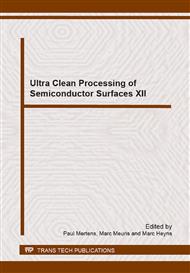p.177
p.183
p.187
p.193
p.197
p.201
p.205
p.209
p.213
Effect of Downstream Plasma Treatment on Dissolution of Fluorocarbon Polymer in Organic Solvents
Abstract:
In back-end of line (BEOL), the fluorinated polymer deposited on dielectric sidewalls during patterning [1,2] must be removed prior to subsequent processing steps to achieve good adhesion and coverage of materials (metals) deposited in the etched features. However, it is known that this type of fluorocarbon polymer is chemically inert to many existing wet clean solutions, including aqueous solutions such as fluoride ion-containing or highly alkaline solutions, and solvent mixtures. Exposure of the polymer to UV irradiation of selective wavelengths and doses significantly modifies the polymer film, which results in substantial removal ability in a subsequent wet clean process [2-3].
Info:
Periodical:
Pages:
197-200
Citation:
Online since:
September 2014
Authors:
Price:
Сopyright:
© 2015 Trans Tech Publications Ltd. All Rights Reserved
Share:
Citation:


